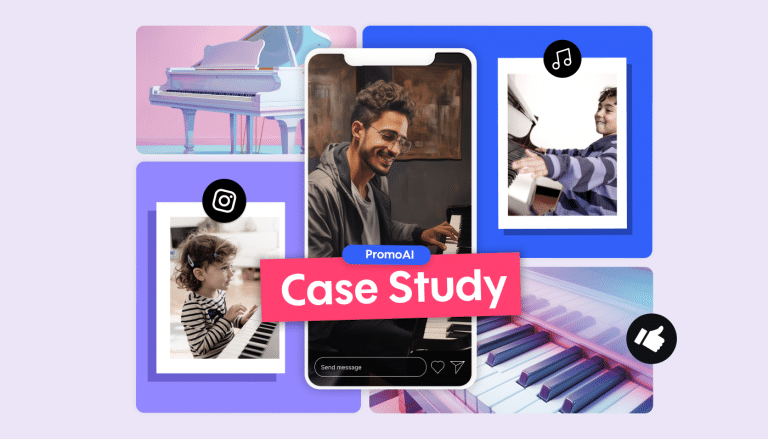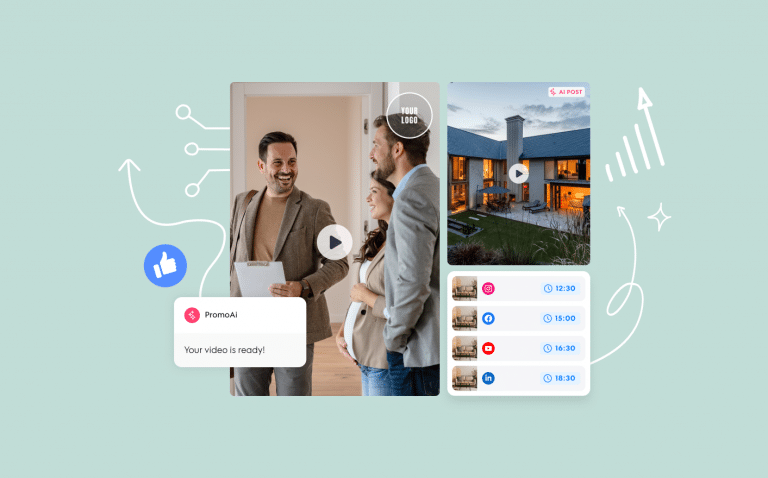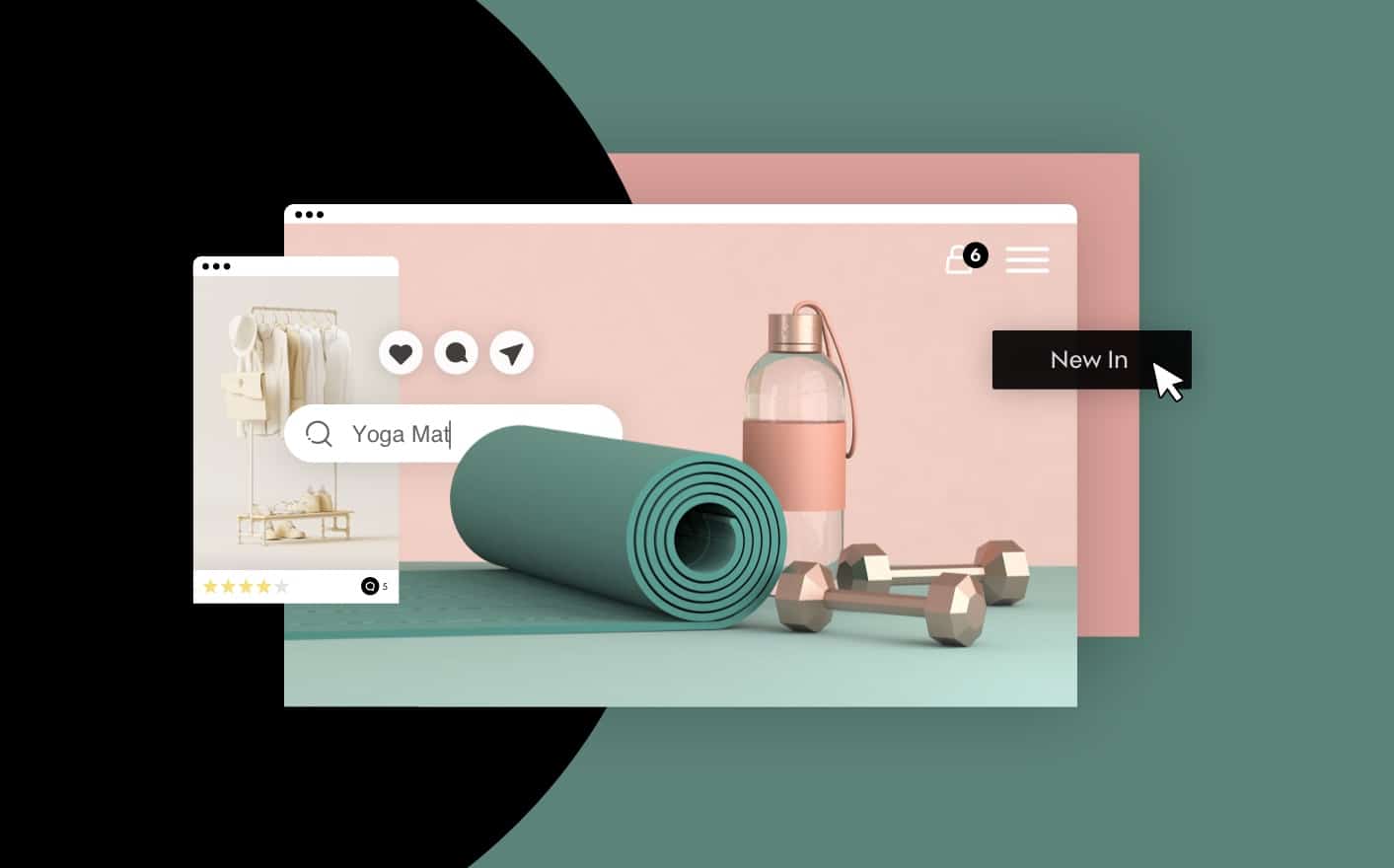
6 Tactics for Creative Ecommerce Promotion on Social Media
- Blog
- Social Media
- 6 Tactics for Creative Ecommerce Promotion on Social Media
Social networking is one of the most popular online activities worldwide. According to Statista, as of 2020, global social media audiences amounted to 3.6 billion users.
The fact is, with so many users on social media, you don’t want your ecommerce brand to be the one not invited to the party. You want to be where your customers are. However, it’s not as simple as just showing up — you’ve got to get creative if you want to stand out and get the right attention.
So, let’s dive into some approaches you can take to promote your ecommerce brand on social media.
1. Collaborating with influencers
When making purchasing decisions, traditional marketing tactics — TV commercials, direct mail and radio ads — don’t make the same impact on today’s consumers as they did in the past. Now, consumers rely mainly on their own research and recommendations from people they trust — like influencers.
An influencer is a trusted source and an authority in their industry; their effectiveness is in their ability to reach a targeted audience across numerous social media platforms. Meaning, an influencer speaking about your product or service can boost sales. For example, marketers saw that influencers brought in $21 for every $1 spent on paid media in the health and pharmaceutical industry.
If an influencer is sharing information about your brand, you will likely see increased traffic to your website, increased brand exposure, new lead generation, the development of a loyal fan base, and insights about your customers.
Earlier this year, LARQ — a company that created the first self-cleaning water bottle — partnered with Golden State Warriors player, Draymond Green, to create a new color option for their bottle.
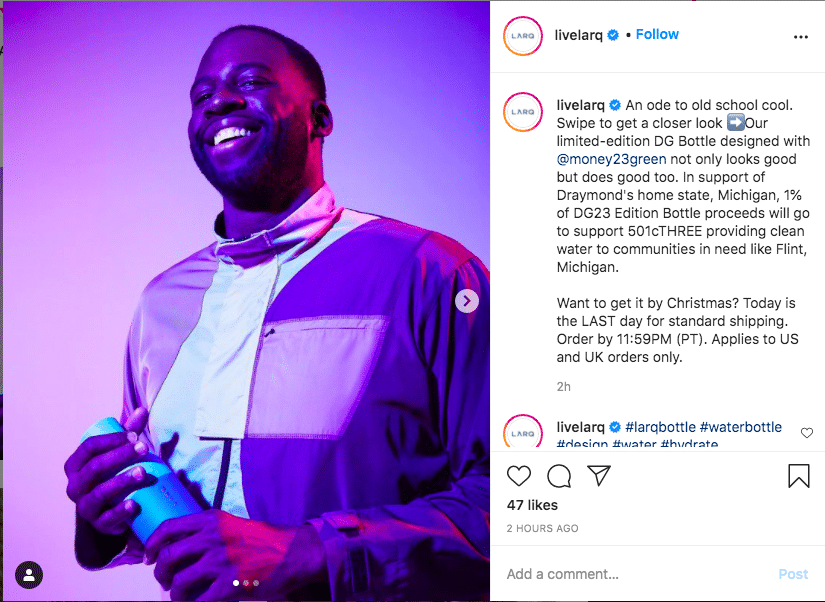 Source: Instagram
Source: Instagram
This collaboration makes sense because LARQ is committed to creating and providing a product that helps get clean water to people and Green has a passion for maintaining a healthy body, mind and planet. Green is also a native of Saginaw, Michigan, which has been affected by the Flint water crisis.
 Source: YouTube
Source: YouTube
“LARQ helps me stay hydrated from home to practice, to games, meetings, and everything in-between with the purest water using UV-C technology. Their mission to make sustainable and healthy hydration options available globally is something I believe in strongly, especially being from the state of Michigan where clean water has been a big issue,” says Draymond Green.
“Having the ability to purify water by just pressing a button is great because I don’t need to buy bottled water anymore, which ultimately means less waste. It also doesn’t hurt that it looks cool too.”
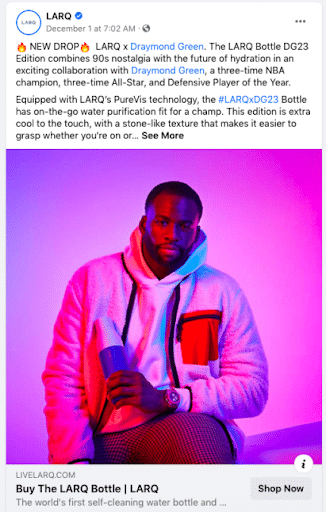 Source: Facebook
Source: Facebook
2. All things customer service
69% of American customers claim they would spend more money with companies that provide better customer service. That includes omnichannel customer service, as well as on social media. Social media has built-in capabilities, such as established messaging and/or chat systems, Plus, customers already use these platforms and are comfortable with these features.
In fact, many customers look to social media for support because they don’t have to make a phone call or send an email to a generic inbox.
Here are a few tips for using social media for customer service:
– Respond to every message
It may sound simple, but not responding to every single message that comes through on social media makes it look like your brand isn’t active or paying attention.
According to Statista survey participants in the U.S., 47% percent indicated they have a more favorable view of brands that respond to customer service questions or social media complaints.
If you turn away that 47%, you could be missing out on sales and revenue.
– Provide service quickly
For online shoppers, it can seem as if everything is delivered quickly. From the fast-loading website to the quick checkout process, consumers have grown accustomed to getting things fast, including customer service.
A survey by Statista in 2018 revealed that 31% of U.S. respondents expect a response in 24 hours or less when they’re communicating via social media.
If you’re planning to offer customer service via social media, make sure you’re ready to monitor your profiles often. If you only check the platforms once a week, you’ll probably miss important messages from customers and leave a bad impression.
To fix this, consider using smart tools such as live chats or chatbots that allow you to respond to your customers faster. In fact, there is also solid data to back it up.
Research shows that 45% of website visitors prefer live chat to other contact channels, as the average response time via chat rounds up to 2 mins 40 seconds, as opposed to 10 hours via social media, or 12 hours via email.
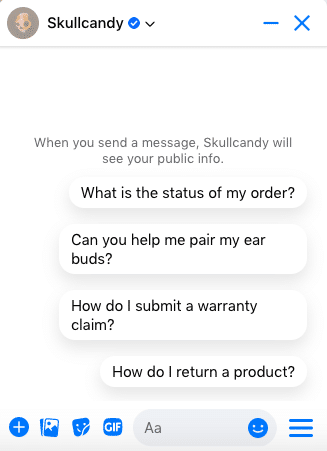 Source: Facebook
Source: Facebook
Skullcandy uses Facebook’s automated chatbot to help with customer service. Utilizing an automated option has several benefits, including:
- Continuous support – Customers will get a reply no matter the hour of day or night.
- Immediate replies – This ensures customers get a fast response without having staff work all hours.
- Chat without human help – Chatbots can automate customer service, along with bookings of orders.
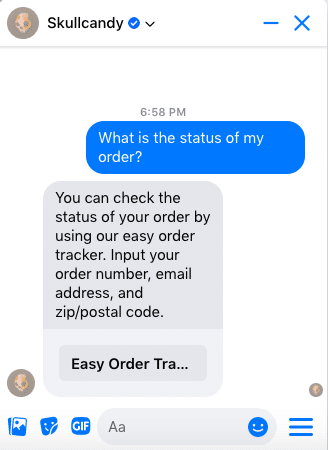 Source: Facebook
Source: Facebook
Skullcandy presents the user with potential questions they may have, and then directs them to answers, FAQ-style.
3. Sharing customer product stories and reviews
Adding customer testimonials to your social media channels allows potential customers to view the honest opinions of people who’ve purchased your products. And once they do, it could be the final push they need to convert from a potential customer to an actual customer.
For instance, during a November 2019 survey of U.S. online customers, 91% of respondents said positive reviews made them more likely to use a business. Here are some tips for how to include reviews and testimonials in your social media posts.
– Build customer rapport
Develop a relationship with your customers before asking for a testimonial. If the customer regularly shares your products on social media, responding to those shares is a good way to build the relationship.
– Highlight customer success
Customer testimonials are great opportunities for showcasing that your business understands the needs of its customers. If a customer’s story shows how your company helped them succeed and achieve their goals, it may lead customers with similar pain points to trust your business.
If possible, try to select a customer story that represents your target audience. This will help you appeal to a larger audience that all have similar needs.
Solo Stove showcases its customer stories on its YouTube page.
 Source: YouTube
Source: YouTube
In this video, the Cragg family shares how they use their Solo Stove at their home. Videos and stories like these help potential customers see how real people use the product, and possibly, how it can be a part of their own life.
4. Demonstrating product assembly and use
A product demonstration is the closest the customer is going to get to the item you’re selling. A product demo can show a potential customer how easy a product is to use or put together. It can also allow a potential customer to see the colors in different lights.
Ultimately, a demo shows the potential customer if the product will really work for them. Of course, every product marketing effort will share ways the customer could use this item in their life. But does it really work? To some customers, a demo is the most honest piece of a marketing campaign. Demonstrations provide proof that the product works the way a company says it does.
Consider food or drink samples that are sometimes offered at a grocery store. It allows customers to try it before they buy it. Another example is beauty bloggers who use YouTube to show how a foundation shade matches or how well an eyeshadow blends.
The key to any product demonstration is to target potential buyer concerns to ease a viewer’s mind.
Burrow — a B2C furniture company that operates on headless commerce — uses videos on its Facebook page to show how easy it is to put together specific Burrow furniture pieces, such as a side table.
 Source: Facebook
Source: Facebook
Showing this aspect of the product can ease a consumer’s mind since they’re getting the product delivered directly to them, and it will require assembly.
5. Showcasing customer content and stories
A report from Stackla in 2019 revealed that consumers are more than 2 times more likely to see user-generated content as more authentic than what’s created by a brand.
Consumers today don’t want to leave anything up to question. They want to know exactly what they’re getting when they pay for a service, experience, or product. Seeing content from other users helps reassure customers who may not yet trust a brand.
User-generated content also has a more authentic, intimate feel than traditional brand content. For example, Bliss World features customers using its products on TikTok.
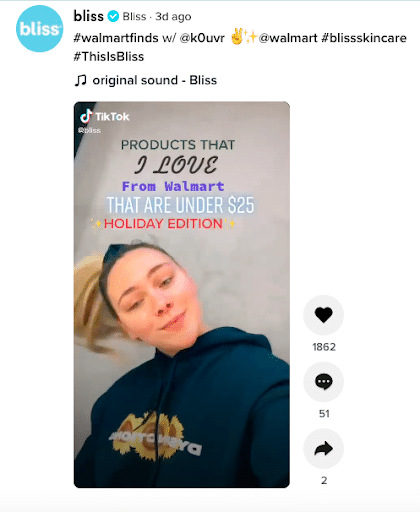 Source: TikTok
Source: TikTok
In this particular video, a customer shows her favorite products under $25 from Walmart. Some of the items are from Bliss World, while others are not. But the video is approachable, it shows the user actually using the products, and it communicates that Bliss World items are sold at Walmart without sounding like a salesperson.
6. In-platform shopping and shoppable posts
Shop Revelry regularly uses its Instagram profile to publish shoppable posts. These posts look similar to standard posts, but they contain additional product information and link directly to the website.
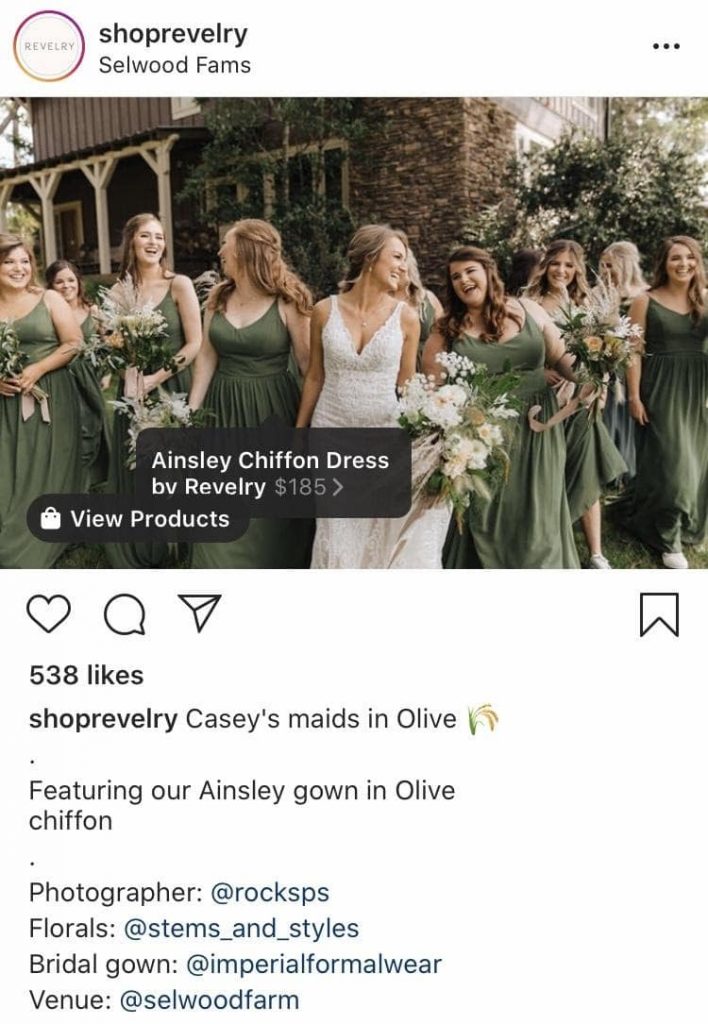 Source: Instagram
Source: Instagram
Allowing customers to shop your products while remaining on their favorite platform is a great way to grow your followers and has many benefits:
– It drives sales
Having the capability to convert users without them leaving one site and going to another means brands can grow sales and gain revenue instantly.
– It increases audience engagement
Shoppable posts often have product details, descriptions, and any additional information that the customer wants to know before making a purchase. Making any piece of content shoppable increases user interaction.
– Get more website traffic
When a user clicks “Shop Now” on a shoppable post, it takes them directly to the item on your website. This means you’ll be getting more qualified traffic from social media to your site since the user is already interested in purchasing the item(s).
– Higher search engine rankings
Utilizing shoppable posts will boost your rankings in search engines and help your standing on social media platforms. More website traffic sends positive signals to search engines and often results in higher rankings and more clicks.
– Streamlined buyer’s journey
Shoppable posts make it possible for customers to shoot through the traditional buyer’s journey and make a purchase in just a few clicks. This results in more leads and opportunities for conversions.
– Improved user experience
A shorter, streamlined buyer’s journey — including a quick checkout process — is more enjoyable for customers. This also means a greater chance of returning customers.
Wrapping Up
Social media has become a necessary place for ecommerce brands to be, but it takes much more than simply creating a profile and randomly publishing posts. The good news is, putting in the effort often brings a lucrative return for ecommerce brands. Not only can you build better brand awareness and gain a loyal following by being creative on social media, but you can also shorten the buyer’s journey, create a more positive customer experience and increase sales and revenue.
Create Any Video In Minutes1
Promo’s suite of online tools and features has you covered
